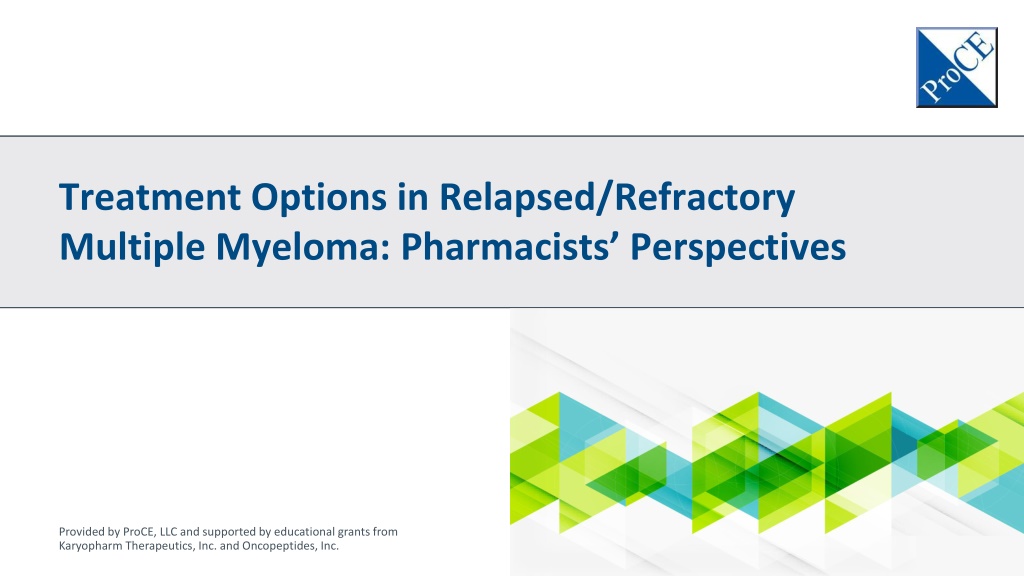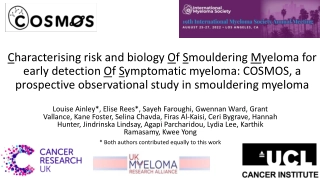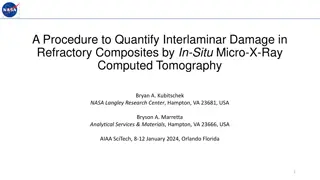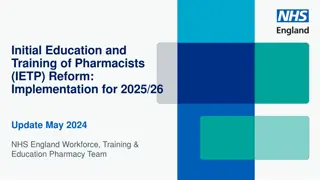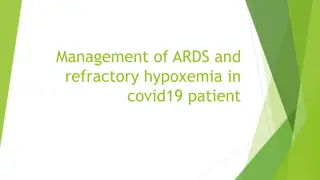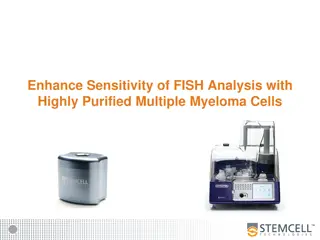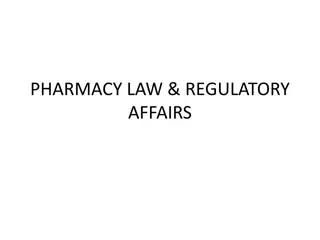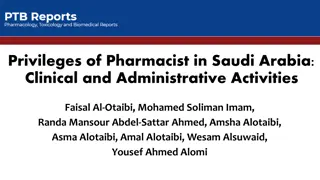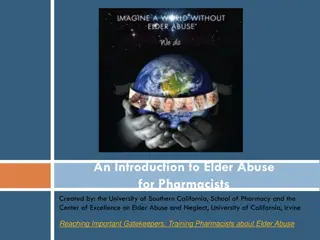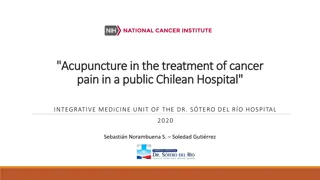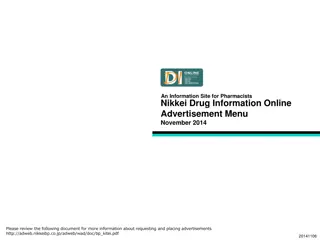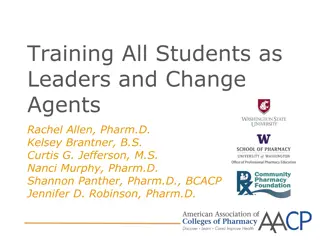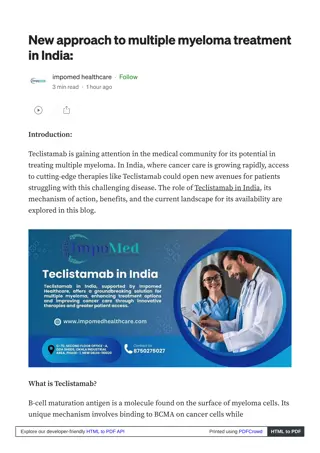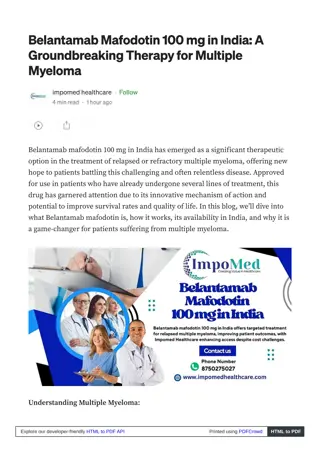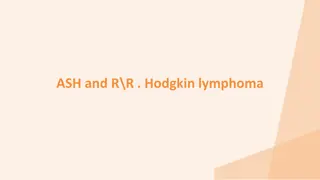Pharmacists' Perspectives on Treatment Options in Relapsed/Refractory Multiple Myeloma
Pharmacists provide valuable insights on current and emerging therapeutic regimens for patients with relapsed/refractory multiple myeloma. This includes discussions on efficacy, safety data, regimen design, adverse event management, counseling points, and more. Educational grants support this activity for pharmacists involved in managing patients with R/R MM.
Download Presentation

Please find below an Image/Link to download the presentation.
The content on the website is provided AS IS for your information and personal use only. It may not be sold, licensed, or shared on other websites without obtaining consent from the author. Download presentation by click this link. If you encounter any issues during the download, it is possible that the publisher has removed the file from their server.
E N D
Presentation Transcript
Treatment Options in Relapsed/Refractory Multiple Myeloma: Pharmacists Perspectives Provided by ProCE, LLC and supported by educational grants from Karyopharm Therapeutics, Inc. and Oncopeptides, Inc.
About These Slides Please feel free to use, update, and share some or all of these slides in your noncommercial presentations to colleagues or patients When using our slides, please retain the source attribution: Slide credit: ProCE.com These slides may not be published, posted online, or used in commercial presentations without permission. Please contact info@ProCE.com for details 2
CE Activity Information and Accreditation ProCE, LLC is accredited by the Accreditation Council for Pharmacy Education as a provider of continuing pharmacy education. ACPE Universal Activity Number 0221-0000-21-168-L01-P has been assigned to this live knowledge- based activity (initial release date 8-2-21). This activity is approved for 1.25 contact hours (0.125 CEU) in states that recognize ACPE providers. The activity is provided at no cost to participants. Participants must complete the online posttest and activity evaluation within 30 days of the activity to receive pharmacy CE credit. No partial credit will be given. Statements of completion will be issued online at www.ProCE.com, and proof of completion will be posted in NABP CPE Monitor profiles. 3 3
CE Activity Information and Accreditation Target Audience The target audience for this activity includes pharmacists, including clinical and health-system pharmacists, board- certified oncology pharmacists, specialty pharmacy and managed care professionals, and other pharmacists responsible for the care and management of patients with relapsed/refractory multiple myeloma. Learning Objectives At the conclusion of this activity, learners should be able to: Discuss the efficacy and safety data of current and emerging therapeutic regimens for patients with R/R MM Given a patient case, design an appropriate therapeutic regimen, including dosing, schedule of administration, and dose modifications for newer classes of agents indicated for R/R MM, with consideration of individual patient and disease characteristics Manage adverse events associated with newer agents and combination regimens in patients with R/R MM therapies Identify key counseling points for patients with R/R MM, including potential risks of therapy and drug drug interactions with new therapies based on comorbidities, comedications, and previous therapies Funding This activity is supported by educational grants from Karyopharm Therapeutics, Inc. and Oncopeptides, Inc. 4 4
Disclosure of Conflicts of Interest ProCE requires instructors, planners, managers, and other individuals who are in a position to control the content of this activity to disclose any relevant conflict of interest (COI) they may have as related to the content of this activity. All identified COI are thoroughly vetted and resolved according to ProCE policy. ProCE is committed to providing its learners with high-quality CME/CE activities and related materials that promote improvements or quality in healthcare and not a specific proprietary business interest of a commercial interest. 5 5
Disclosures The faculty reported the following relevant financial relationships or relationships to products or devices they have with ineligible companies related to the content of this CME/CE activity: Kathryn Maples, PharmD, BCOP, has disclosed that she has received consulting fees from GlaxoSmithKline, Janssen, Karyopharm, and Sanofi. Tim Peterson, PharmD, BCOP, has disclosed that he has received consulting fees from GlaxoSmithKline. The planners/managersreported the following relationships: Gordon Kelley; Timothy A. Quill, PhD; and Kristen Rosenthal, PhD; have no relevant conflicts of interest to report. ProCE staff members have no relevant conflicts of interest to report. 6
Disclosure of Unlabeled Use This educational activity may contain discussion of published and/or investigational uses of agents that are not indicated by the FDA. The planners of this activity do not recommend the use of any agent outside of the labeled indications. The opinions expressed in the educational activity are those of the faculty and do not necessarily represent the views of the planners. Please refer to the official prescribing information for each product for discussion of approved indications, contraindications, and warnings. Disclaimer Learners have an implied responsibility to use the newly acquired information to enhance patient outcomes and their own professional development. The information presented in this activity is not meant to serve as a guideline for patient management. Any procedures, medications, or other courses of diagnosis or treatment discussed or suggested in this activity should not be used by healthcare professionals without evaluation of their patient s conditions and possible contraindications and/or dangers in use, review of any applicable manufacturer s product information, and comparison with recommendations of other authorities. 7 7
Faculty Kathryn Maples, PharmD, BCOP Clinical Pharmacy Specialist, Multiple Myeloma Department of Pharmacy Emory Healthcare Winship Cancer Institute Atlanta, Georgia Tim Peterson, PharmD, BCOP Clinical Pharmacy Specialist, Multiple Myeloma Memorial Sloan Kettering Cancer Center New York, New York 8
Tim Peterson, PharmD, BCOP ProCE.com 9
Multiple Myeloma: Background Incurable malignancy characterized by uncontrolled plasma cell proliferation US prevalence in 2021 (American Cancer Society) Estimated 34,920 new diagnoses and 12,410 deaths Lifetime risk: 1 in 132 (0.76%) Median age at diagnosis: ~69 yr Precursor states MGUS (monoclonal gammopathy of undetermined significance) SMM (smoldering multiple myeloma) Siegel R. CA Cancer J Clin. 2021;71(1):7-33. American Cancer Society. www.cancer.org/cancer/multiple-myeloma/about/key-statistics.html Slide credit: ProCE.com 10
Multiple Myeloma Diagnosis/Staging Myeloma-Defining Events (CRAB) Calcium: corrected Ca2+ >11.0 mg/dL or >1 mg/dL higher than ULN Renal dysfunction: SCr >2.0 mg/dL or CrCl <40 mL/min Anemia: Hb <10 g/dL or >2 g/dL below normal Bone: 1 osteolytic bone lesions on skeletal radiograph, CT, or PET-CT ISS Stage 2M <3.5 mg/L and albumin 3.5 g/dL I II Neither stage I or III 2M 5.5 mg/L III R-ISS Stage 5-yr PFS 5-yr OS ISS stage I and normal LDH and no high-risk cytogenetic abnormalities I 55% 82% SLiM Criteria II Neither R-ISS stage I or III 36% 62% S: BMPC 60% Li:FLCR 100 or 0.01 M:>1 focal marrow lesion 5 mm on MRI ISS stage III and LDH above ULN and/or presence of high- risk cytogenetic abnormalities III 24% 40% BMPC: bone marrow plasma cells; CrCl, creatinine clearance; FLCR: serum free light chain ratio; SCr, serum creatinine 2M: beta-2 macroglobulin; ULN: upper limit of normal High risk cytogenetics: del(17p), t(4;14), t(14;16) Rajkumar SV et al. Lancet Oncol. 2014;15(12):e538-48. Palumbo A et al. J Clin Oncol. 2015;33(26):2863-69. Sonneveld P et al. Blood. 2016;127(24):2955-62. Rajkumar SV et al. ASCO Education Book. 2016;May 19:e418-23. Slide credit: ProCE.com 11
Treating Multiple Myeloma Is a Marathon, Not a Sprint! Strategic vs tactical considerations: tolerability AND efficacy key with combination regimens Asymptomatic Symptomatic Relapsing Refractory Active myeloma Relapse M-Protein Level Relapse 4th- to 20th- line therapy MGUS or smoldering myeloma Remission 1st-line therapy 2nd- line therapy 3rd-line therapy Slide credit: ProCE.com Adapted from Borrello. Leuk Res. 2012;36:S3. Richardson. Blood Cancer J. 2018;8:109.
Multiple Myeloma Remains Incurable Evolving treatment paradigm Novel agents and combinations in both frontline and relapsed settings improve depth (MRD) and duration of responses Selinexor Isatuximab ? 60% Pomalidomide Carfilzomib Yr of Diagnosis, SEER Statistics Relative 5-Yr Survival by 55% Belantamab mafodotin Melphalan flufenamide Idecabtagene vicleucel Daratumumab Elotuzumab Ixazomib Lenalidomide Bortezomib 50% 45% 40% 35% IMiD PI mAb Novel targets AutoSCT AlloSCT 30% Steroids 25% Alkylators 20% 1960 1960 1970 1970 1980 1980 1990 1990 2000 2000 2010 2010 2015 2020 2020 2030 Slide credit: ProCE.com 13 Shah UA, Mailankody S. BMJ 2020;370:m3176. Howlader NA et al (eds). SEER cancer statistics review, 1975-2017. NCI. Bethesda, MD. 2020. https://seer.cancer.gov/csr/1975_2017/.
Multiple Myeloma Frontline Management Induction Therapy Triplet preferred over doublet Consider inclusion of monoclonal antibody (eg, daratumumab) Consider transplant eligibility Consolidation Maintenance Therapy Lenalidomide (category 1) Bortezomib Ixazomib (category 1, transplant) Lenalidomide/bortezomib Melphalan-based autologous stem cell transplant Early (immediate) Delayed (at first relapse) Continuation of primary induction therapy Slide credit: ProCE.com 14 NCCN Clinical Practice Guidelines in Oncology: Multiple Myeloma (Version 7.2021).
NCCN Guideline Recommendations for R/R MM Preferred Regimens Bortezomib + lenalidomide + dexamethasone Isatuximab-irfc + pomalidomide + dexamethasone (1) Carfilzomib + lenalidomide + dexamethasone (1) Ixazomib + lenalidomide + dexamethasone (1) Daratumumab + bortezomib + dexamethasone (1) Ixazomib + pomalidomide + dexamethasone Daratumumab + carfilzomib + dexamethasone (1) Pomalidomide + bortezomib + dexamethasone (1) Daratumumab + lenalidomide + dexamethasone (1) Other Recommended Regimens/Useful in Certain Circumstances (Not an Exhaustive List) Belantamab mafodotin-blmf Idecabtagene vicleucel Carfilzomib + dexamethasone twice wkly (1) or once wkly Melphalan flufenamide + dexamethasone Daratumumab + pomalidomide + dexamethasone Panobinostat + bortezomib + dexamethasone Daratumumab + cyclophosphamide + bortezomib + dexamethasone Selinexor + bortezomib + dexamethasone (1) Elotuzumab + dexamethasone + lenalidomide or pomalidomide Selinexor + dexamethasone daratumumab or pomalidomide Isatuximab-irfc + carfilzomib + dexamethasone Venetoclax + dexamethasone [for t(11;14)] May repeat primary induction therapy if relapse occurs after >6 mo Category 2A unless otherwise noted. Slide credit: ProCE.com 15 NCCN Clinical Practice Guidelines in Oncology: Multiple Myeloma (Version 7.2021).
Current and Emerging Therapeutic Regimens for R/R Multiple Myeloma ProCE.com 16
Therapeutic Agents in R/R Myeloma Proteasome Inhibitors Monoclonal Antibodies Immunomodulatory Agents Agents with Novel MoAs Corticosteroids Bortezomib Daratumumab Thalidomide Idecabtagene vicleucel Dexamethasone Carfilzomib Isatuximab-irfc Lenalidomide Melphalan flufenamide Prednisone Ixazomib Elotuzumab Pomalidomide Belantamab mafodotin-blmf Selinexor Venetoclax [if t(11;14)] Panobinostat Slide credit: ProCE.com 17
Daratumumab Combinations in R/R Myeloma Line of Therapy Regimen Trial Efficacy/Safety Endpoints ORR: 29.2% Median PFS: 3.7 mo All-grade anemia (33%), thrombocytopenia (25%), infusion related reactions (42%) SIRIUS (Phase II; n=106) 3+ Daratumumab IV ORR: 92.9% (vs 76.4%) CR: 56.6% (vs 23.2%) Median PFS: 44.5 mo (vs 17.5 mo) All-grade neutropenia: 63.3% (vs 48.0%) POLLUX (Phase III; n=569) Daratumumab IV + lenalidomide + dexamethasone (vs lenalidomide + dexamethasone) 1+ ORR: 85% (vs 63%) CR: 30% (vs 10%) Median PFS: 16.7 mo (vs 7.1 mo) All-grade neutropenia 20% (vs 10%) CASTOR (Phase III; n=498) Daratumumab IV + bortezomib + dexamethasone (vs bortezomib + dexamethasone) 1+ ORR: 69% (vs 46%) Median PFS: 12.4 mo (vs 6.9 mo) All-grade pneumonia 18% (vs 11%) APOLLO (Phase III; n=304) Daratumumab SubQ or IV + pomalidomide + dexamethasone (vs pomalidomide + dexamethasone) 1+ LYRA (Phase II; n=101) Daratumumab IV + cyclophosphamide + bortezomib + dexamethasone ORR (relapsed): 71.4% 12-month PFS (relapsed): 66.2% 1stand 2+ ORR: 84% (vs 75%) Median PFS: NR (vs 15.8 mo) Grade 3 cardiac failure 4% (vs 8%) CANDOR (Phase III; n=466) Daratumumab IV + carfilzomib + dexamethasone (vs carfilzomib + dexamethasone) 1-3 Slide credit: ProCE.com 18 Lonial S et al. Lancet. 2016;387(10027):1551-60. Bahlis NJ et al. Leukemia. 2020;34:1875-84. Mateos MV et al. Clin Lymphoma Myeloma Leuk. 2020;20(8):509-18. Dimopoulos MA et al. Lancet Oncol. 2021;22:801-12. Yimer H et al. Br J Haematol. 2019;185:492-502. Dimopoulos M et al. Lancet. 2020;396:186-197.
COLUMBA: Daratumumab and Hyaluronidase-fihj Subcutaneous formulation FDA approved May 2020 NCCN Guidelines: may substitute daratumumab and hyaluronidase-fihj for IV as part of any daratumumab- containing regimen COLUMBA Phase III, noninferiority trial comparing IV to SC administration (n = 522) Overall Response Rate Infusion Reactions Interventions 13% Daratumumab 1,800 mg + hyaluronidase 30,000 units SubQ (OR: 0.28, 95% CI: 0.18- 0.44) 41% 37% Daratumumab 16 mg/kg IV (RR: 1.11, 95% CI: 0.89-1.37) 34% Slide credit: ProCE.com 19 NCCN Clinical Practice Guidelines in Oncology: Multiple Myeloma (Version 7.2021). Mateos MV et al. Lancet Haematol. 2020;7:e370-90.
Isatuximab-irfc Combinations in R/R Myeloma Trial Line of Therapy Regimen Efficacy/Safety Endpoints PFS: 11.5 mo (vs 6.5 mo) All-grade infusion reactions: 38% All-grade upper respiratory infections: 28% (vs 17%) ICARIA-MM (Phase III; n=307) Isatuximab-irfc IV + pomalidomide + dexamethasone (vs pomalidomide + dexamethasone) 2+ ORR: 87% (vs 83%) PFS: NR (vs 19.15 mo) All-grade infusion reactions: 46% (vs 3%) Grade 3 neutropenia: 19% (vs 7%) IKEMA (Phase III; n=302) Isatuximab-irfc IV + carfilzomib + dexamethasone (vs carfilzomib + dexamethasone) 1+ Slide credit: ProCE.com 20 Attal M et al. Lancet. 2019;394:2096-107. Moreau P et al. Lancet. 2021;397:2361.
Elotuzumab Combinations in R/R Myeloma Trial Line of Therapy Regimen Efficacy/Safety Endpoints Elotuzumab IV + lenalidomide + dexamethasone (vs lenalidomide + dexamethasone) Elotuzumab 10 mg/kg/wk x 8 doses, then Q2W thereafter ORR: 79% (vs 66%) PFS: 19.4 mo (vs 14.9 mo) Grade 3 lymphopenia 77% (vs 49%) ELOQUENT-2 (Phase III; n=646) 1-3 Elotuzumab IV + pomalidomide + dexamethasone (vs pomalidomide + dexamethasone) Elotuzumab 10 mg/kg/wk x 8 doses, then 20 mg/kg Q4W thereafter ORR: 53% (vs 26%) PFS: 10.3 mo (vs 4.7 mo) Similar grade 3 adverse events ELOQUENT-3 (Phase II; n=117) 2+ Slide credit: ProCE.com 21 Lonial S et al. N Engl J Med. 2015;373(7):621-31. Dimopoulos MA et al. N Engl J Med. 2018;379:1811-22.
Which of the following monoclonal antibodybased regimens is FDA approved as a second or later line of therapy? Audience Response A. Daratumumab + bortezomib + lenalidomide + dexamethasone B. Isatuximab-irfc + carfilzomib + dexamethasone C. Elotuzumab monotherapy D. Daratumumab + thalidomide + dexamethasone 22
Targeting Exportin (XPO1) in R/R Myeloma Selinexor: first-in-class, oral nuclear export inhibitor Initial FDA approval July 2019 in combination with dex after 4 previous Tx (including 2 PIs, 2 IMiDs, and anti-CD38 mAb) Subsequent approval in Dec 2020 with bortezomib/dex after 1 previous Tx Trial Line of Therapy Regimen Efficacy/Safety Endpoints ORR: 26% PFS: 3.7 mo All-grade thrombocytopenia (73%), anemia (67%), neutropenia (40%), nausea (72%) STORM (Phase IIb; n=122) Selinexor PO + dexamethasone Selinexor 80 mg twice wkly 3+ ORR: 76.4% (vs 62.3%) PFS: 13.9 mo (vs 9.5 mo) All-grade thrombocytopenia (60%), anemia (36%), neutropenia (15%), nausea (50%) Selinexor PO + bortezomib + dexamethasone (vs bortezomib + dexamethasone) Selinexor 100 mg once wkly BOSTON (Phase III; n=402) 1-3 STOMP (dara) (Phase Ib/II; n=34) Selinexor PO + daratumumab + dexamethasone RP2D: Selinexor 100 mg once wkly or 60 mg twice wkly ORR: 73% PFS: 12.5 mo (dara naive) 3+ STOMP (pom) (Phase Ib/II; n=52) Selinexor PO + pomalidomide + dexamethasone RP2D: Selinexor 100 mg once wkly or 60 mg twice wkly ORR: 54.3% (pom naive) PFS: 12.3 mo (pom naive) 2+ Slide credit: ProCE.com 23 Chari A et al. N Engl J Med. 2019;381(8):727-38. Grosicki S et al. Lancet. 2020;396:1563-73. Gasparetto C et al. eJHaem. 2021;2:56-65. Chen CI et al. ASH Annual Meeting. 2020;136 (suppl 1):18-19.
Targeting BCMA in R/R Myeloma BCMA (B-cell maturation antigen) Expressed on both normal and malignant plasma cells Preferential expression on mature B lymphocytes Ideal therapeutic target, potential biomarker for diagnosis and monitoring Belantamab mafodotin-blmf First FDA approved agent targeting BCMA (August 2020); after 4 previous Tx (including an anti-CD38 mAb, PI, and IMiD) Idecabtagene vicleucel First CAR T-cell FDA approved in MM (March 2021); after 4 previous lines of Tx (including an IMiD, PI, and anti-CD38 mAb) Slide credit: ProCE.com 24 Shah N et al. Leukemia. 2020;34:985-1005. Belantamab mafodotin-blmf [prescribing information].
DREAMM-2: Belantamab Mafodotin in R/R Myeloma Belantamab mafodotin-blmf First-in-class antibody drug conjugate, targeting BCMA IgG1 anti-BCMA monoclonal antibody conjugated to microtubule inhibitor, monomethylauristatin F (MMAF) Phase II, randomized to 2 dosing cohorts 2.5 mg/kg vs 3.4 mg/kg over 30 min every 21 days 3+ prior lines of therapy, including refractory to IMiDs, PIs, and intolerant or refractory to CD38 antibodies Ocular substudy Lubricating eye drops 4 times/day No additional benefit to prophylactic corticosteroid eye drops 2.5 mg/kg Cohort (n=97) 3.4 mg/kg Cohort (n=99) Efficacy Outcomes Overall Response VGPR 31% 34% 19% 20% Safety Outcomes (grade 3, unless specified) Ocular Toxicities - Keratopathy - Blurred vision (all grade) - Dry eye (all grade) 27% 22% 14% 21% 30% 23% Hematologic Toxicities - Thrombocytopenia - Anemia - Neutropenia 20% 20% 9% 34% 25% 15% Additional Non- Hematologic Toxicities - Infusion-related reactions (all grade) 21% 16% Slide credit: ProCE.com 25 Lonial S et al. Lancet Oncol. 2020;21:207-21. Wahab A et al. Front Oncol. 2021;11:678634.
KarMMa: Ide-cel in R/R Myeloma Idecabtagene vicleucel (ide-cel) First FDA approved CAR T-cell construct in myeloma BCMA-directed CAR T-cell, containing 4-1BB costimulatory domain Phase II, multicenter (n=128) Lymphodepletion with cyclophosphamide, fludarabine Median 6 prior lines, all patients refractory to last line ORR: 73% PFS: 8.8 mo CAR-T persistence CAR+ T cells found in 59% of patients at 6 mo and 36% of patients at 12 mo Common all-grade toxicities included: Neutropenia (91%), anemia (70%), and thrombocytopenia (63%) CRS reported in 84% of patients Grade 3 in 5% (n = 7) Neurotoxicity reported in 18% of patients Grade 3 in 3% (n = 4) Slide credit: ProCE.com 26 Munshi N et al. N Engl J Med. 2021;384:705-16. Idecabtagene vicleucel PI.
Melphalan Flufenamide: PeptideDrug Conjugate First-in-class peptide drug conjugate FDA approved February 2021 in combination with dex after 4 previous lines of Tx with disease refractory to 1 PI, 1 IMiD, and an anti-CD38 mAb High lipophilicity allows rapid internalization and conversion from prodrug to active alkylating agent, melphalan HORIZON Phase II, single arm trial (n = 157) Melphalan flufenamide 40 mg IV through central venous access every 4 weeks Dexamethasone 40 mg PO (20 mg in patients 75) once wkly Median 5 prior lines, 76% of patients with triple-class-refractory disease ORR: 29% PFS: 4.2 mo Most common grade 3 toxicities included neutropenia (79%), thrombocytopenia (76%), anemia (43%) Slide credit: ProCE.com 27 Richardson PG et al. J Clin Oncol. 2021;39(7):757-67. Melphalan flufenamide PI.
Targeting BCL-2 in R/R Myeloma: Venetoclax NCCN: reserved for relapsed myeloma in patients with t(11;14) Not FDA approved for multiple myeloma Venetoclax + dex Phase II trial in patients with t(11;14) (N = 31) Venetoclax 800 mg PO daily (no dose escalation required) Dex 40 mg PO Days 1, 8, 15 of 21-day cycle Efficacy ORR: 48% DoR: 61% at 1 yr BELLINI Phase III, randomized trial (n = 291) Bortezomib + dexamethasone venetoclax Venetoclax 800 mg PO daily (no dose escalation required) Efficacy ORR: 85% (vs 70%) Median PFS: 22.4 mo (vs 11.5 mo) Most common grade 3 AEs include hematologic toxicities (lymphopenia, neutropenia, thrombocytopenia, anemia) No occurrences of tumor lysis syndrome In BELLINI, unselected patients had higher rate of infections, early deaths with venetoclax + Vd Slide credit: ProCE.com 28 Kaufman Jl et al. Am J Hematol. 2021; 96:418-427. Kumar SK et al. Lancet Oncol. 2020;21:1630-42. NCCN Clinical Practice Guidelines in Oncology: Multiple Myeloma (Version 7.2021).
Which of the following is most accurate regarding belantamab mafodotin-blmf in the DREAMM-2 trial? Audience Response A. Ocular toxicity occurred more at 2.5 mg/kg than 3.4 mg/kg B. There were no occurrences of infusion-related reactions C. Response rates were similar between 2.5 mg/kg and 3.4 mg/kg D. Corticosteroid drops significantly reduced eye toxicity 29
Kathryn Maples, PharmD, BCOP ProCE.com 30
Designing Appropriate Therapeutic Regimens ProCE.com 31
Criteria for Relapse Increase in serum/urine M protein Increase in involved free light chain levels Increase in bone marrow plasma cell percentage Biochemical relapse Presence/worsening of CRAB criteria Development of new bone lesions or soft tissue plasmacytoma Hyperviscosity related to serum paraprotein Clinical relapse Slide credit: ProCE.com 32 NCCN Clinical Practice Guidelines in Oncology: Multiple Myeloma (Version 7.2021).
NCCN Guideline Recommendations 3 classes of therapy for previously treated MM Preferred regimens, other recommended regimens, and useful in certain circumstances Various combinations of proteasome inhibitors, immunomodulatory agents, monoclonal antibodies, and drugs with novel mechanisms of actions Currently no universal standard for optimal therapy sequence in R/R disease Slide credit: ProCE.com 33 NCCN Clinical Practice Guidelines in Oncology: Multiple Myeloma (Version 7.2021).
Selecting Treatment for R/R MM: General Principles Patient Age/frailty Performance status Lifestyle Patient preference Caregiver support Comorbidities Renal status Neuropathy Cardiac Diabetes Cytopenias Disease Disease burden: ISS Rate of progression Marrow burden CRAB symptoms Extramedullary disease Biology LDH Cytogenetics: t(4;14) del(17p) t(14;16) amp(1q) t(11;14) Treatment Toxicity Myelosuppression Infections Neuropathy Secondary cancers Ocular toxicity Cost Administration route Relapsed vs refractory Depth/duration of response to prior treatment Regimen Triplet* (eg, KRd) is preferred over doublet Include 1 agent from a new or nonrefractory class Previously used agents may be effective in different combinations Treat to maximum response Maintain on 1 agent until progression or intolerability *2 active classes plus dexamethasone. Laubach. Leukemia. 2016;30:1005. NCCN. clinical practice guidelines in oncology: multiple myeloma (v6.2021). Sanchez. Expert Rev Hematol. 2020;13:943. Sonneveld. 2016;101:396. Slide credit: ProCE.com 34
Myeloma: Treatment Options Beyond First Relapse First Relapse Options Additional Options OR Any triplet combination therapy options listed for first relapse that have not been tried Belantamab mafodotin Selinexor + Vd or single-agent selinexor Melphalan flufenamide CAR T-cell therapy Bispecific antibodies (in clinical trial) Venetoclax in patients with t(11;14) (off label) VDT-PACE like anthracycline-containing regimens Cyclo/bendamustine/melphalan regimens Panobinostat + PI Quadruplet regimens (2 new drugs; triplet preferred) Isa-Pd or Dara-Pd; Isa-Kd or Dara-Kd; or KPd Slide credit: ProCE.com 35 NCCN Clinical Practice Guidelines in Oncology: Multiple Myeloma (Version 7.2021).
Patient Case Mary is a 61-yr-old female with no significant past medical history who was diagnosed with R-ISS stage 1 multiple myeloma She started on induction therapy with RVD followed by high-dose therapy and autologous stem cell transplant with achievement of CR After transplant, she was started on lenalidomide maintenance therapy at 10 mg on Days 1-21 of 28-day cycle After 2.5 yr on maintenance therapy, she was found to have disease progression with a rising paraprotein Slide credit: ProCE.com 36
Which of the following would you recommend as second-line therapy for Mary? Audience Response A. Bortezomib/lenalidomide/dexamethasone B. Daratumumab or isatuximab/pomalidomide/dexamethasone C. Belantamab mafodotin D. Melphalan flufenamide 37
Which anti-CD38 monoclonal antibody can be given as a subcutaneous injection? Audience Response A. Daratumumab B. Isatuximab C. Both of the above D. Neither of the above 38
Choosing Therapy for Patients With R/R MM Chosen 1st-line Therapy Options for 2nd-line Therapy Daratumumab or Isatuximab + Pomalidomide/Dex Daratumumab or Isatuximab + Carfilzomib/Dex Induction Therapy Consolidation Len Maintenance Until PD Carfilzomib/Pomalidomide/Dex Elotuzumab/Pomalidomide/Dex Ixazomib/Pomalidomide/Dex Bortezomib/Pomalidomide/Dex Carfilzomib/Cyclophosphamide/Dex Clinical trial should be considered for all eligible patients Slide credit: ProCE.com 39
Choosing Therapy for Patients With R/R MM Chosen 1st-line Therapy Options for 2nd-line Therapy Subsequent Therapy Combination Not Received 2nd Line Daratumumab or Isatuximab + Pomalidomide/Dex Daratumumab or Isatuximab + Carfilzomib/Dex Induction Therapy Consolidation Len Maintenance Until PD Carfilzomib/ Cyclophosphamide/Dex Selinexor/ Bortezomib/Dex Carfilzomib/Pomalidomide/Dex Elotuzumab/Pomalidomide/Dex Belantamab Mafodotin Ixazomib/Pomalidomide/Dex Idecabtagene Vicleucel Bortezomib/Pomalidomide/Dex Melphalan Flufenamide Carfilzomib/Cyclophosphamide/Dex Clinical trial should be considered for all eligible patients Slide credit: ProCE.com 40
Choosing Therapy for Patients With R/R MM Chosen 1st-line Therapy Options for 2nd-line Therapy Subsequent Therapy Combination Not Received 2nd Line Daratumumab or Isatuximab + Pomalidomide/Dex Daratumumab or Isatuximab + Carfilzomib/Dex Induction Therapy Consolidation Len Maintenance Until PD Pomalidomide/ Cyclophosphamide/Dex Selinexor/ Bortezomib/Dex Carfilzomib/Pomalidomide/Dex Elotuzumab/Pomalidomide/Dex Belantamab Mafodotin Ixazomib/Pomalidomide/Dex Idecabtagene Vicleucel Bortezomib/Pomalidomide/Dex Melphalan flufenamide Carfilzomib/Cyclophosphamide/Dex Clinical trial should be considered for all eligible patients Slide credit: ProCE.com 41
Choosing Therapy for Patients With R/R MM Chosen 1st-line Therapy Options for 2nd-line Therapy Subsequent Therapy Combination Not Received 2nd Line Daratumumab or Isatuximab + Pomalidomide/Dex Daratumumab or Isatuximab + Carfilzomib/Dex Induction Therapy Consolidation Len Maintenance Until PD Anti-CD38 mAb/ PI or Pom/Dex Selinexor/ Bortezomib/Dex Carfilzomib/Pomalidomide/Dex Elotuzumab/Pomalidomide/Dex Belantamab Mafodotin Ixazomib/Pomalidomide/Dex Idecabtagene Vicleucel Bortezomib/Pomalidomide/Dex Melphalan flufenamide Carfilzomib/Cyclophosphamide/Dex Clinical trial should be considered for all eligible patients Slide credit: ProCE.com 42
Anti-CD38 Monoclonal Antibody Considerations SC Daratumumab IV Daratumumab Isatuximab FDA-Approved Indications Newly diagnosed MM: DaraRd, Dara-VMP, Dara-VTD R/R MM: Dara monotherapy, DaraVd, DaraRd, DaraPd Newly diagnosed MM: Dara-VMP, DaraRd, Dara-VTD R/R MM: Dara monotherapy, DaraVd, DaraRd, DaraPd, DaraKd R/R MM: IsaPd IsaKd Dosing 1800 mg flat dose (15 mL) 16 mg/kg in 1000 mL (dose 1), then 500 mL Cycles 1-2: weekly Cycles 3-6: Q2W or Q3W Cycles 7+: monthly Infusion rates vary based on dose; range from ~1.5-8 hr 10 mg/kg in 250 mL Schedule Cycles 1-2: weekly Cycles 3-6: Q2W or Q3W Cycles 7+: monthly SC push over 3-5 min Cycle 1: weekly Cycles 2+: biweekly Administration Infusion rates vary based on first, second, or subsequent infusion; range from ~1.25-3.5 hr Pearls Observe after cycle 1, day 1; length of time will be institution specific Can consider split dose for cycle 1 and give 8 mg/kg over Days 1 and 2 No data in patients previously treated with daratumumab Daratumumab/hyaluronidase-fihj) [prescribing information]. March 2021.Daratumumab [prescribing information]. March 2021. Isatuximab [prescribing information]. March 2021. Slide credit: ProCE.com 43
Carfilzomib Dosing Considerations Phase 3 Study: A.R.R.O.W Objective To compare PFS for once- vs twice-weekly carfilzomib in patients with R/R MM after 2-3 treatments, including PI and IMiD 478 patients randomized 1:1 to once-weekly (n=240) or twice- weekly (n=238) dosing Results Median PFS: 11.2 mo with once-weekly vs 7.6 mo with twice weekly (HR, 0.69; 95% CI, 0.54-0.83) Adverse events Grade 3 higher with once weekly (68%) vs twice weekly (62%) Anemia: 18% vs 18% Pneumonia: 10% vs 7% Thrombocytopenia: 7% vs 7% Grade 3 or worse cardiac failure: 3% vs 4% Once weekly: 70 mg/m2 Days 1, 8, 15 Twice weekly: 27 mg/m2 Days 1, 2, 8, 9, 15, 16 Primary endpoint: PFS Conclusion Once-weekly dosing yielded higher PFS with similar adverse event profile Slide credit: ProCE.com 44 Moreau P, et al. Lancet Oncol. 2018;19:953-964.
Nontransplant Eligible Patient David is an 81-yr-old male with past medical history significant for diabetes and hypertension who is diagnosed with R-ISS stage 1 multiple myeloma He is started on induction therapy with daratumumab, lenalidomide, and dexamethasone per the MAIA trial After 1.5 yr, he is experiencing disease progression with rising paraprotein How would his first-relapse treatment regimens be different? Slide credit: ProCE.com 45
Choosing Therapy for Patients With R/R MM Chosen 1st-line Therapy Options for 2nd-line Therapy Bortezomib/Pomalidomide/Dex Daratumumab + Lenalidomide Until PD Carfilzomib/Pomalidomide/Dex Ixazomib/Pomalidomide/Dex Elotuzumab/Pomalidomide/Dex Cyclophosphamide/Pomalidomide/Dex Carfilzomib/Cyclophosphamide/Dex Clinical trial should be considered for all eligible patients Slide credit: ProCE.com 46
Managing Adverse Events Associated With R/R MM Therapies ProCE.com 47
Patient Case Mary received daratumumab/pomalidomide/dexamethasone followed by carfilzomib/cyclophosphamide/dexamethasone She presents to your clinic with disease progression; you were asked to provide education on a selinexor-based treatment or belantamab mafodotin Slide credit: ProCE.com 48
Audience Response What is the emetic potential of selinexor? A. Minimal B. Low C. Moderate D. High 49
Mary has grade 2 keratopathy in the right eye only prior to cycle 3 of belantamab mafodotin. What is the best course of action? A. Continue therapy since the grade 2 AE is only in one eye Audience Response B. Hold until AE is grade 1, then resume at current dose C. Hold until AE is grade 1, then resume at reduced dose D. Permanently discontinue therapy with belantamab mafodotin 50
